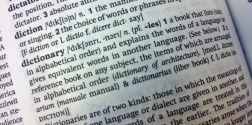The word larrikin is about as Australian as you can get. We are proud of our larrikin streak and those who personify it like Paul Hogan’s character in his Crocodile Dundee movies. Or even Dawn Fraser in the 1960s. But where did the word come from?
The Macquarie Dictionary has an explanation of what a larrikin is from the late 1800s where they were described in a book called Jonah by Louis Stone:
They were dressed in the height of larrikin fashion — tight-fitting suits of dark cloth, soft black felt hats, and soft white shirts with new black mufflers round their necks in place of collars — for the larrikin taste in dress runs to a surprising neatness. But their boots were remarkable, fitting like a glove, with high heels and a wonderful ornament of perforated toe-caps and brass eyelet-holes on the uppers.
There were larrikins in both Sydney (Darlo and the Rocks) and Melbourne (Collingwood). They were also usually on the wrong side of the law – the hoodlums of their day.
Melissa Bellanta describes the evolution of larrikinism in her book and she found that the term was not so positive:
Today, being a larrikin has positive connotations and we think of it as the key to unlocking the Australian identity: a bloke who refuses to stand on ceremony and is a bit of scallywag. When it first emerged around 1870, however, larrikin was a term of abuse, used to describe teenage, working-class hell-raisers who populated dance halls and cheap theatres. Crucially, the early larrikins were female as well as male.
—Melissa Bellanta, Larrikins: A History (2012)
 Experts have written about the larrikin streak in Australian culture, and many have ideas about its origins. Some say that larrikinism was a reaction to the authorities in Australia’s early days as a penal colony. Those who were part of a criminal gang called the Rocks Push were often referred to as larrikins. They used to hang out in The Rocks in Sydney in the late 19th and early 20th centuries and were well-known for their antisocial behaviour and dress codes.
Experts have written about the larrikin streak in Australian culture, and many have ideas about its origins. Some say that larrikinism was a reaction to the authorities in Australia’s early days as a penal colony. Those who were part of a criminal gang called the Rocks Push were often referred to as larrikins. They used to hang out in The Rocks in Sydney in the late 19th and early 20th centuries and were well-known for their antisocial behaviour and dress codes.
But gradually the term larrikins became known as way to describe those who were not criminals but definitely non-conformist. To be a larrikin is now recognised as being cool and not accepting the status quo if there is a good reason not to do so. It has become a recognised part of our Australian culture and it influences our art, youth culture and politics.
For example, in 1965 the Australian swimmer, Dawn Fraser, was banned from competition by the Australian Swimming Union for various incidents at the previous year’s Summer Olympics. But later, Fraser was described as having a ‘larrikin streak’ and was appointed an Officer of the Order of Australia in 1988. This is a good example of how we view our Australian larrikins with fondness these days.
What do you think? Should we and do we still admire larrikins?







